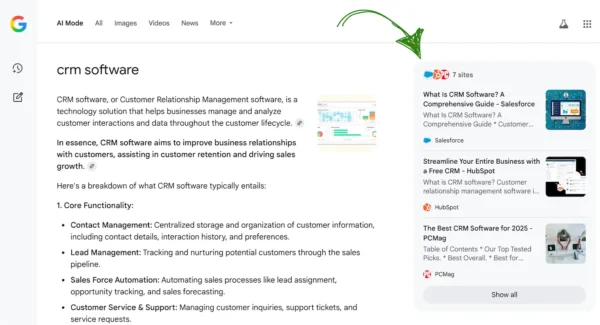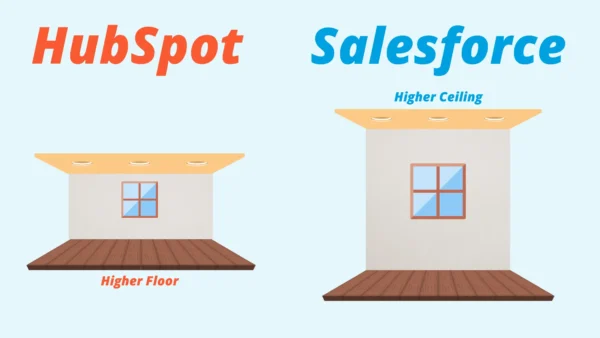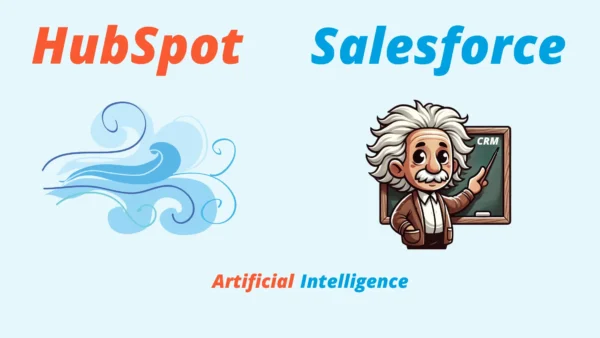Many organizations that go through a Customer Relationship Management (CRM) selection process include Salesforce and HubSpot on their vendor shortlists.
Multiple resources on the web take a feature-comparison approach to the differences between the two solutions.
Ahref’s web analytics tool indicates that 80% of people’s online search intent is feature-comparison-oriented when looking for information about HubSpot vs. Salesforce.
In this post, we’ll buck the features-first trend and focus mainly on the high-level differences between the two vendors. Here’s why:
Deciding between HubSpot and Salesforce is not as simple as reading feature comparison articles and scheduling sales presentations.
We recommend that teams evaluating CRM at mid-sized companies and enterprises follow a structured CRM buying process to select the best-fit solution.
Summarize this post with AI:
Vendor Overviews
HubSpot and Salesforce are both established powerhouses in data management and business process automation.
Salesforce was founded in 1999 in San Francisco, California, by Marc Benioff and Parker Harris.
Brian Halligan and Dharmesh Shah founded HubSpot in Boston, Massachusetts, in 2006.
Both companies are publicly traded on the New York Stock Exchange (NYSE).
Products
Salesforce began as a sales force automation (SFA) system and eventually became a comprehensive suite of business applications, some of which were acquired.
Due to the company’s origins, Salesforce Sales Cloud remains one of its most popular offerings. Salesforce offers over a dozen other products, including Service Cloud, Tableau, and Slack.
HubSpot began as an inbound marketing and content management platform for website pages and blog posts. The company later added Sales, Service, Operations, and Commerce products, or ‘Hubs’ as HubSpot calls them.
Both companies have seen enterprise adoption in their respective flagship categories.
Editorial Note: We do not earn commissions or margins from the vendors we cover on this website.
Marketing & Sales
You often hear about these two companies because they are both considered marketing ‘forces of nature.’
According to Ahrefs, HubSpot.com receives approximately 2 million organic search visitors per month, while Salesforce.com receives around 3 million. This is significant traffic for B2B company websites.
We prompted Google’s AI Mode with ‘crm software’; the only two brand results for the category were HubSpot and Salesforce.

Both companies have elite sales organizations. As we jokingly tell our CRM selection services clients, “Prepare to have a new best friend” if you sign up for a trial or free edition.
Longevity Effects
As with any software platform, greater longevity than competitors has its advantages and disadvantages.
It usually means richer features and functionality.
However, more time on the market can also mean more baggage, such as ongoing transitions from legacy interfaces and outdated methods for accomplishing specific administrative tasks. Certain configurations require a bit of a ‘baling wire and bubble gum’ construct.
There can be both positive and negative effects from longevity.
Given the two companies’ origins, many organizations use both Salesforce and HubSpot — HubSpot for marketing automation and Salesforce for sales, customer support, and custom business applications.
Some companies using both platforms are considering moving entirely to one or the other.
Companies that use neither platform may be considering one or the other.
Several high-level differences between Salesforce and HubSpot should be considered when deciding between the two.
Scope and Complexity of Business Needs
Generally speaking, Salesforce is well-suited for organizations with multiple departments, complex record and field visibility requirements (i.e., “Who Sees What”), data-intensive needs, advanced reporting and dashboard capabilities, deep customization options, and robust validation rules.
Salesforce is well-structured for organizations subject to industry and regulatory compliance standards, such as HIPAA, CMMC, FedRAMP, and SOC 2.
HubSpot has settings to encrypt Sensitive Data.
HubSpot is often the preferred platform for startups and SMBs seeking integrated sales and marketing capabilities. It’s easy to get started, especially for non-technical individuals and organizations new to CRM.
A Reddit commenter summarized these differences by saying that HubSpot has a higher floor and Salesforce has a significantly higher ceiling.

Extending the CRM Database
CRM consultants and administrators often create custom objects, also known as custom CRM database tables, to support business requirements.
Custom objects are supported in any Salesforce edition, whereas creating custom objects requires one of HubSpot’s enterprise editions.
Native vs. Integrated Marketing Functionality
HubSpot began as a marketing automation platform. When HubSpot introduced Sales Hub, the functionality was added natively to the existing platform.
Because of this unified codebase, sales and marketing users can share many of the same properties (fields), rather than an admin having to replicate fields across different systems and then set up mappings and precedence rules.
The entire awareness-to-order journey can be managed in a single container.
Conversely, Salesforce does not have natively developed marketing automation functionality.
However, Salesforce integrates with several marketing automation systems, including HubSpot, ActiveCampaign, and its internal Pardot and Marketing Cloud offerings.
While cloud-to-cloud integrations are better than ever, they require more ongoing maintenance than all-in-one systems.
The Consultant Ecosystems
A positive longevity effect for Salesforce is the sheer volume of worldwide administrators and developers.
Given the number of people involved, Salesforce has dubbed this global collective the “Salesforce Economy.”
While a broad range of marketing agencies and independent consultants are experts in HubSpot Marketing Hub and CMS Hub, HubSpot’s consultant ecosystem for Sales, Service, Operations, and Commerce Hubs is newer.
If you plan to use a third party for CRM implementation and integration services, the Salesforce ecosystem currently has more collective experience.
The HubSpot & Salesforce App Marketplaces
Third-party CRM apps typically include integrations, add-ons, and natively installed enhanced functionality.
HubSpot’s App Marketplace has over 1,700 apps.
Salesforce’s AppExchange has over 7,000 third-party apps.
HubSpot’s app marketplace is designed for ease of use and the needs of small- to medium-sized businesses (SMBs). In contrast, Salesforce’s AppExchange offers a broader, more customizable set of tools, many of which are suited for larger companies seeking extensive functionality.
For example, while HubSpot’s App Marketplace offers integrations with various accounting systems, AccountingSeed provides a complete accounting system on the Salesforce platform that can be installed from the AppExchange.
Freemium vs. Only Pay-For
While Salesforce allocates time and money to many organizations and individuals, it does not offer free licenses to business customers.
Update: In November 2025, Salesforce began offering a free, two-user version.
On the other hand, HubSpot continues to use an extensive freemium model with ‘lite’ functionality for up to five users at no charge. This pricing model offers a more extensive try-before-you-buy experience than a time-limited free trial.
CRM vendor pricing changes frequently, but as of the last update to this article, HubSpot’s Sales Hub Enterprise edition was $150 per user per month, and Salesforce’s Sales Cloud Enterprise Edition was $165 per user per month.
Scope of Product Offerings
Salesforce’s growth through acquisitions means it offers a range of products beyond its core CRM platform. While product brand names have changed, notable past acquisitions include Slack, Tableau, ExactTarget, Pardot, Demandware, SteelBrick, and Own Company.
HubSpot has acquired far fewer companies than Salesforce and tends to build all functionality in-house on a single platform.
HubSpot offers a point-and-click content management system (CMS), whereas Salesforce does not. Customers can build entire websites on the same platform as the other HubSpot apps they use.
AI Features
Both vendors offer artificial intelligence capabilities across various functions, such as analytics, email creation, sales forecasting, lead scoring, and customer service.
The vendor’s AI features allow teams to streamline processes and personalize interactions at scale.
Salesforce’s Agentforce lets customers build AI agents, a “proactive, autonomous application that provides specialized, always-on support to employees or customers.”
Salesforce promotes the guardrails of its Einstein Trust Layer.
HubSpot’s Breeze aims to “boost productivity, scale growth, and unlock actionable insights.” It makes AI-driven features accessible to businesses of all sizes.
Its tools emphasize ease of use, with AI-powered agents for content, social media, prospecting, and website visitor interaction.
Other Breeze features include data enrichment, buyer intent, and form shortening.

Business Process Automation Tools
Business process automation tools, such as workflow designers, have become indispensable to businesses.
Today, these tools are a must-have for sales, marketing, service, and custom applications.
HubSpot’s Workflows were initially designed for marketing requirements but have been applied to address similar business needs for sales, service, and operations.
Salesforce’s Flows offer more design and data options, making them more complex to configure than HubSpot’s Workflows.
HubSpot’s Sequences are a predefined series of scheduled tasks and touchpoints that help users connect with prospects and customers.
Salesforce Engagement Cadences perform a similar function.
HubSpot’s lead scoring app offers more options than Salesforce’s.
The User Experience and Interface
CRM system user adoption is a perennial challenge. CRM vendors are seeking ways to enhance the user experience.
Salesforce uses a traditional ‘lists and forms’ CRM interface for standard objects like Leads, Accounts, Contacts, and Opportunities.
By contrast, the HubSpot record detail view de-emphasizes traditional-looking forms and fields, instead emphasizing activities. HubSpot’s robust user interface is particularly well-suited for companies focusing heavily on sales pursuits and Account-Based Marketing (ABM).
A thorough analysis is crucial for achieving the highest CRM success before implementing significant changes to CRM software platforms.
It’s not just about the general differences between HubSpot and Salesforce, but also how each platform addresses your organization’s unique needs.




